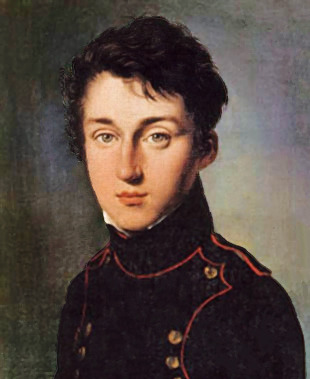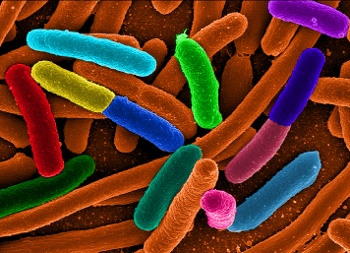Thermodynamics of Life
September 13, 2013
The
science of
thermodynamics was invented to quantify the operation of
heat engines so that they might be improved. When you're stoking a
steam engine, you want as much of that precious
coal as possible converted into useful
work.
Nearly two
centuries ago,
Sadi Carnot developed a simplified model of a heat engine known as a
Carnot heat engine. On the basis of this model, he was able to state
Carnot's theorem, that the maximum
efficiency of a heat engine is a simple function of the difference in
temperature between a hot
reservoir (the engine) and a cold reservoir (its
environment); viz,
η = 1 - (TC/TH)
where
η is the efficiency,
TC is the temperature of the cold reservoir, and
TH is the temperature of the hot reservoir. You don't need to be a
statistical mechanic to realize that a very hot engine gets near-perfect efficiency.

French physicist, Nicolas Léonard Sadi Carnot (1796-1832)
Carnot's research in thermodynamics led to the later definition of entropy.
(An 1813 portrait of Carnot in school uniform at age seventeen by Louis-Léopold Boilly (1761-1845), via Wikimedia Commons.)
Real life is not that kind, so the
efficiency of engines is less than 100%. Simple steam engines of the type that enabled the
industrial revolution have less than 10% efficiency, with improvements such as
condensers bringing that up to about 25%.
Steam turbines of the type used in
electrical power plants have a
theoretical efficiency of about 63%, based on a steam temperature of 565°
C and a condenser temperature of 35°C, but an actual efficiency of about 40%.
Standard
Diesel engines have an efficiency of about 40%, which is increased to about 50% with
turbo-charging.
Automotive gasoline engines have efficiencies in the range of 20-30%. All that lost energy becomes
waste heat, so you can see why there's
research into
energy harvesting from
vehicle exhaust.
Living organisms are essentially specialized
chemical reactors, so the
laws of thermodynamics apply to them as well. Organisms maintain their
order by feeding from order in the
universe; that is, they generate
entropy. As a consequence of the
second law of thermodynamics, they also generate
heat.
Jeremy England, a
professor of
physics at the
Massachusetts Institute of Technology, has just calculated the thermodynamic efficiency for replication of the simple
bacterium,
E. coli.[1-2]

A false color image of E. coli bacteria.
(Via Wikimedia Commons.)
Bacteria reproduce by
cell division. In the case of E. coli, this twenty minute process involves feeding, and a rearrangement of
molecules such as
DNA and
peptides before
division.[2] The key to England's calculation is the essential
reversibility of thermodynamics. He looked at the reverse process of what would be needed for two cells to become one by reversing the chemical reactions of replication.[2]
The largest contributor to these reactions are 1.6 billion
peptide bonds which form the basis of
proteins. Calculating the bond energies gave the result that E. coli replication is an efficient process. Only six times more energy is expended than in an ideal thermodynamic system; that is, replication operates at about seventeen percent efficiency.[2] Says England,
"Given what the bacterium is made of, and given how rapidly it grows, what would be the minimum amount of heat that it would have to exhaust into its surroundings? When you compare that with the amount of heat it's actually exhausting, they're roughly on the same scale... It's relatively close to the maximum efficiency."[2]
Of course, seventeen percent is not a hundred percent. Bacteria still need to perform biological tasks other than replication. Still, there's the possibility that bacteria could be
genetically engineered to grow faster, since there's nothing in principle against this.[2]
England speculates also what this finding means in the
pre-biotic emergence of
self-replicating nucleic acids.[1]
RNA bonding is less energetic than DNA bonding, which suggests that RNA may have evolved first, since it's thermodynamically capable of replicating faster.[2]
References:
- Jeremy L. England, "Statistical physics of self-replication," Journal of Chemical Physics, vol. 139, no. 12 (to appear, September 28, 2013), Document No. 121923 (8 pages).
- Anne Trafton, "How quickly can a bacterium grow?" MIT Press Release, August 27, 2013.
- England Lab Web Site at MIT.
Permanent Link to this article
Linked Keywords: Science; thermodynamics; heat engine; steam engine; coal; work; century; Sadi Carnot; Carnot heat engine; Carnot's theorem; thermal efficiency; thermodynamic temperature; thermal reservoir; environment; statistical mechanics; statistical mechanic; French; physicist; Nicolas Léonard Sadi Carnot; entropy; Louis-Léopold Boilly (1761-1845); Wikimedia Commons; engine efficiency; industrial revolution; condenser; steam turbine; power station; electrical power plant; theory; theoretical; Celsius; C; Diesel engine; turbocharger; turbo-charging; automobile; aAutomotive; gasoline engine; waste heat; research; energy harvesting; exhaust gas; vehicle exhaust; living organism; chemical reactor; laws of thermodynamics; order and disorder; universe; entropy; second law of thermodynamics; heat; Jeremy England; professor; physics; Massachusetts Institute of Technology; bacteria; bacterium; E. coli; false color image; Escherichia coli; cell division; molecule; DNA; peptide; reversible process; reversibility; peptide bond; protein; genetic engineering; genetically engineered; abiogenesis; pre-biotic emergence; self-replication; self-replicating; nucleic acid; RNA.